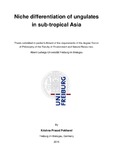Please use this identifier to cite or link to this item:
http://archive.nnl.gov.np:8080/handle/123456789/355| Title: | Niche differentiation of ungulates in sub-tropical Asia |
| Authors: | Pokharel, Krishna Prasad |
| Keywords: | ecological niche |
| Issue Date: | 29-Mar-2019 |
| Abstract: | Differential resource use allows a diversity of species to co-exist in a particular area by specializing in individual ecological niches. Four-horned antelope Tetracerus quadricornis is endemic to the Indian subcontinent, and has a restricted distribution in Nepal and India; however, barking deer Muntiacus vaginalis is relatively common throughout its wide distribution range. We wanted a better understanding of their habitats and how these two similarly sized solitary ungulates manage to coexist in lowland Nepal. We used fecal pellet belt transect surveys in the Babai valley, Bardia National Park to study the habitat associations of both species. We found empirical evidence that four-horned antelope prefer hill sal forest and deciduous hill forest at higher elevations whereas barking deer preferred riverine and sal forest in lower elevations. We found a clear niche differentiation of four-horned antelope and barking deer that made the coexistence of these similarly sized solitary ungulates possible. Hence, resource partitioning is the key to coexistence of these solitary ungulates, and the fine-grained habitat mosaic of different forest types in the study landscape appears to be the underlying feature. Therefore, maintaining the habitat mosaic and preserving valuable hill sal and deciduous hill forests will facilitate the coexistence of herbivores in sub-tropical regions. |
| URI: | http://103.69.125.248:8080/xmlui/handle/123456789/355 |
| Appears in Collections: | 500 Natural sciences and mathematics |
Files in This Item:
| File | Description | Size | Format | |
|---|---|---|---|---|
| Pokharel, KP__PhD Thesis.pdf | 2.96 MB | Adobe PDF |  View/Open |
Items in DSpace are protected by copyright, with all rights reserved, unless otherwise indicated.